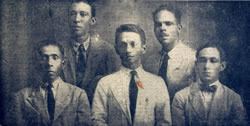 | ||
The Banana massacre (Spanish: Matanza de las bananeras or Masacre de las bananeras) was a massacre of workers for the United Fruit Company that occurred on December 6, 1928 in the town of Ciénaga near Santa Marta, Colombia. After U.S. officials in Colombia, along with United Fruit representatives, portrayed the worker's strike as "communist" with "subversive tendency", in telegrams to the U.S. Secretary of State, the United States government threatened to invade with the U.S. Marine Corps if the Colombian government did not act to protect United Fruit’s interests. An unknown number of workers died after the conservative government of Miguel Méndez sent the Colombian army to end a union strike for better working conditions.
Contents
Gabriel García Márquez depicted a fictional version of the massacre in his novel One Hundred Years of Solitude, as did Álvaro Cepeda Samudio in his La Casa Grande.
Strike
The workers of the banana plantations in Colombia went on strike in December 1928. They demanded written contracts, eight-hour work days, six-day work weeks and the elimination of food coupons. The strike turned into the largest labor movement ever witnessed in the country until then. Radical members of the Liberal Party, as well as members of the Socialist and Communist Parties, participated.
Massacre
An army regiment from Bogotá was dispatched by the government to deal with the strikers, which it deemed to be subversive. Whether these troops were sent in at the behest of the United Fruit Company did not clearly emerge.
The troops set up their machine guns on the roofs of the low buildings at the corners of the main square, closed off the access streets, and after a five-minute warning opened fire into a dense Sunday crowd of workers and their wives and children who had gathered, after Sunday Mass, to wait for an anticipated address from the governor.
Number of dead
General Cortés Vargas, who commanded the troops during the massacre, took responsibility for 47 casualties. In reality, the exact number of casualties has never been confirmed. Herrera Soto, co-author of a comprehensive and detailed study of the 1928 strike, has put together various estimates given by contemporaries and historians, ranging from 47 to as high as 2,000. Survivors, popular oral histories and written documents give figures 800-3000 killed, adding that the killers threw them into the sea.
Among the survivors was Luis Vicente Gámez, later a famous local figure, who survived by hiding under a bridge for three days. Every year after the massacre he delivered a memorial service over the radio.
Another version by official Jose Gregorio Guerrero said that the number of dead was nine: eight civilians and one soldier. Guerrero added that Jorge Eliécer Gaitán had exaggerated the number of deaths.
Official U.S. telegrams
The Telegram from Bogotá Embassy to the U.S. Secretary of State, Frank B. Kellogg, dated December 5, 1928, stated:
The Telegram from Santa Marta Consulate to the U.S. Secretary of State, dated December 6, 1928, stated:
The Telegram from Bogotá Embassy to the U.S. Secretary of State, dated December 7, 1928, stated:
The Telegram from the U.S. Department of State to Santa Marta Consulate, dated December 8, 1928, stated:
The telegram from Santa Marta Consulate to the U.S. Secretary of State, dated December 9, 1928, stated:
The Dispatch from Santa Marta Consulate to the U.S. Secretary of State, dated December 11, 1928, stated:
The Dispatch from Bogotá Embassy to the U.S. Secretary of State, dated December 11, 1928, stated:
The Dispatch from U.S. Bogotá Embassy to the U.S. Secretary of State, dated December 29, 1928, stated:
The Dispatch from U.S. Bogotá Embassy to the US Secretary of State, dated January 16, 1929, stated:
Consequences
Guerrilla movements in Colombia such as the Revolutionary Armed Forces of Colombia (FARC) argued that the growth of Communism in Colombia was triggered by atrocities like these, and called it state terrorism. The Banana massacre was one of the principal causes of the Bogotazo, and the subsequent era of violence known as La Violencia.
